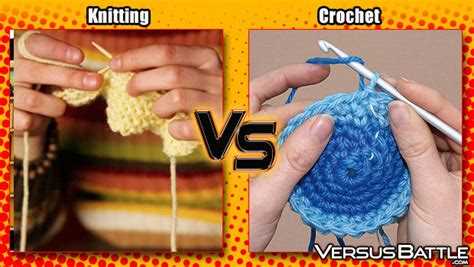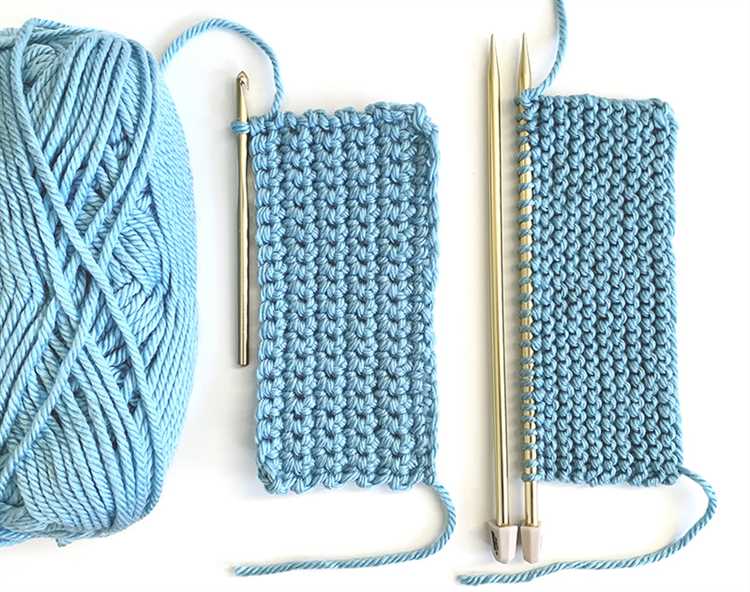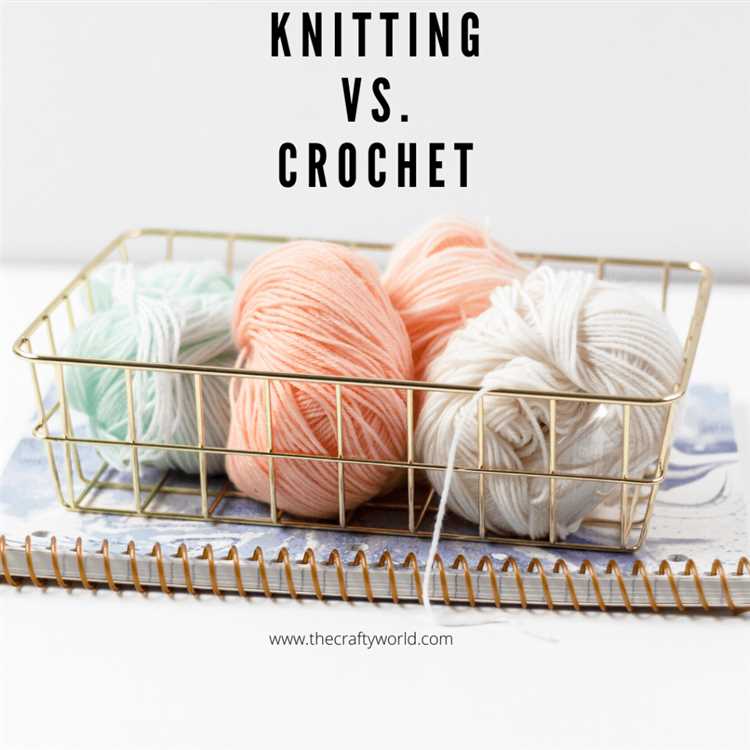Crocheting and knitting are two popular crafts that involve working with yarn to create various items such as clothing, accessories, and home decor. While they may seem similar at first glance, there are actually several key differences between crocheting and knitting that set them apart.
Crocheting is a technique that uses a single hook to create stitches, while knitting involves the use of two pointed needles. This fundamental difference in tools leads to variations in the types of stitches and patterns that can be created. Crocheting is often considered to be more versatile, as the single hook allows for greater flexibility in stitch manipulation and pattern design. On the other hand, knitting is known for producing a fabric that is more stretchy and drapes differently.
Another difference between crocheting and knitting lies in the way the stitches are formed. Crocheting uses one loop at a time, creating a more textured and thicker fabric. Knitting, on the other hand, involves multiple loops simultaneously, resulting in a smoother and thinner fabric. This distinction in stitch formation can also impact the overall speed and ease of each craft.
Despite these differences, crocheting and knitting also share many similarities. Both crafts require patience, attention to detail, and a love for working with yarn. They also provide a creative outlet and a sense of accomplishment when a project is completed. Additionally, crocheting and knitting can both be enjoyed as hobbies or as a means to make gifts for loved ones.
Whether you choose to crochet or knit, both crafts offer a wonderful way to relax, unleash your creativity, and produce beautiful handmade items. So whether you prefer the versatility of crocheting or the smoothness of knitting, there is no wrong choice when it comes to these beloved fiber arts.
History and Origins
The origins of both crocheting and knitting can be traced back thousands of years.
Crocheting:
Crocheting is believed to have originated in the early 19th century in Europe. The exact origins of crocheting are not well-documented, but it is thought to have evolved from earlier forms of lace-making and needlework.
In the early years, crocheting was primarily done by hand using a single hook. Fine thread or yarn was used to create intricate patterns and designs. It was a popular craft among the upper classes, and the delicate and intricate nature of crocheted items made them highly valued.
Knitting:
Knitting has a longer history, with origins dating back to ancient times. The earliest examples of knitting have been found in Egypt and date back to the 5th century. Knitting was also practiced in other parts of the world, including ancient China, Arabia, and South America.
Knitting was initially done using two handheld needles, which were used to form loops and create the fabric. Unlike crocheting, knitting was not limited to fine thread but could also be done with thicker yarns, making it suitable for garments and blankets.
Development and Popularity:
Both crocheting and knitting continued to evolve and gain popularity over the centuries. Crocheting became more accessible to the general public with the invention of the crochet hook, which made it easier to create stitches and patterns.
Knitting also underwent changes with the introduction of knitting machines in the 18th century, which mechanized the process and increased production. Knitting became a popular pastime during the Industrial Revolution and was also associated with social and economic movements, such as the Arts and Crafts movement.
Today, both crocheting and knitting are widely practiced crafts around the world. While they share similarities in their techniques and use of yarn, each has its own unique history and traditions that continue to be passed down through generations.
Tools and Materials
Both crocheting and knitting require specific tools and materials to create different types of patterns and designs. While some tools and materials are common to both crafts, there are also some differences in what is used.
Crocheting Tools and Materials
- Crochet Hooks: This is the primary tool used in crocheting. Crochet hooks come in various sizes, ranging from small to large, and are made from different materials such as aluminum, plastic, or wood.
- Yarn: Yarn is the main material used in crocheting. It comes in different colors, textures, and weights. The choice of yarn can vary depending on the project and desired outcome.
- Tapestry Needle: A tapestry needle is used to weave in loose ends and finish off the project. It is an essential tool in crocheting to ensure neat and clean finishes.
- Stitch Markers: Stitch markers are small rings or clips used to mark specific stitches or sections in the pattern to help the crocheter keep track of their work.
- Measuring Tape: A measuring tape is used to measure the size and dimensions of the project. It is important for ensuring accuracy and consistency in crochet work.
Knitting Tools and Materials
- Knitting Needles: Knitting needles come in different sizes and lengths. They can be straight, double-pointed, or circular depending on the type of knitting project.
- Yarn: Similar to crocheting, yarn is the primary material used in knitting. It comes in various colors, textures, and weights, providing versatility for different knitting projects.
- Tapestry Needle: Just like in crocheting, a tapestry needle is used in knitting for weaving in loose ends and finishing off the project.
- Stitch Markers: Stitch markers are also used in knitting to mark specific stitches or sections in the pattern for easy tracking of knitting progress.
- Measuring Tape: A measuring tape is essential in knitting to measure the size and dimensions of the project accurately.
Overall, crocheting and knitting share similar tools and materials, such as yarn, tapestry needles, stitch markers, and measuring tapes. The primary difference lies in the type of needle used – crochet hooks for crocheting and knitting needles for knitting. Despite this difference, both crafts offer a wide range of possibilities for creating beautiful and intricate designs using various tools and materials.
Basic Techniques
Crocheting:
- Crocheting is done using a single crochet hook and a yarn or thread.
- Stitches are created by looping the yarn around the hook and pulling it through loops on the hook.
- There are different types of crochet stitches, including single crochet, double crochet, and half double crochet.
- Crocheting can be done in rows or in rounds.
- The finished fabric created with crochet tends to be denser and thicker than knitted fabric.
Knitting:
- Knitting is done using two knitting needles and a yarn.
- Stitches are created by inserting the needle into loops on the other needle and wrapping the yarn around the needle.
- There are different types of knitting stitches, including knit stitch and purl stitch.
- Knitting is typically done in rows.
- The finished fabric created with knitting tends to be stretchy and flexible.
Differences in Techniques:
| Crocheting | Knitting |
|---|---|
| Uses a single hook. | Uses two needles. |
| Creates stitches by pulling loops through loops. | Creates stitches by inserting the needle into loops. |
| Can be done in rows or rounds. | Typically done in rows. |
| Produces a denser and thicker fabric. | Produces a stretchy and flexible fabric. |
Similarities in Techniques:
- Both crocheting and knitting use yarn or thread to create fabric.
- Both techniques require basic knowledge of various stitches to create different patterns.
- Both techniques can be used to create a wide range of items, including blankets, scarves, and hats.
- Both techniques involve creativity and patience.
Finished Products
Both crocheting and knitting can be used to create a wide range of finished products. While there is some overlap between the two crafts, they do have some differences in terms of the types of items that are often made.
Crocheting:
- Crocheting is often used to create items with a thicker, more textured appearance.
- Common finished products in crocheting include blankets, scarves, hats, and amigurumi (small stuffed animals or dolls).
- Crocheted items often have a more flexible and stretchy quality.
Knitting:
- Knitting is typically used to create items with a smoother, more even appearance.
- Common finished products in knitting include sweaters, socks, gloves, and shawls.
- Knitted items often have a denser and warmer quality.
Both crocheting and knitting can also be used to create decorative items such as doilies and afghans.
Overall, while crocheting and knitting have some differences in terms of the types of finished products that are often made, both crafts offer a wide range of possibilities for creating beautiful and functional items.
Speed and Difficulty
When it comes to speed, knitting and crocheting have different paces. Generally, crochet is considered to be faster than knitting because crochet stitches are larger and therefore take fewer stitches to cover the same area. However, this can vary depending on the individual’s skill level and experience with the craft.
In terms of difficulty, both knitting and crocheting have their own challenges. Some people find knitting to be more difficult to learn because it involves working with two needles and manipulating yarn in specific ways. It can take time to master different knitting techniques, such as casting on, knitting, purling, and binding off.
Crocheting, on the other hand, uses a single hook and involves fewer types of stitches. It may be easier for beginners to pick up crochet because the basic stitches are simpler and more repetitive. However, mastering more complex crochet techniques and patterns can still be a challenge.
- Knitting:
- Slower pace
- Working with two needles
- Complex techniques to master
- Crocheting:
- Faster pace
- Working with a single hook
- Basic stitches are simpler
In conclusion, the speed and difficulty of knitting and crocheting can vary depending on the individual’s skill level. While crochet is generally faster and may be easier to learn for beginners, both crafts have their own challenges that can be overcome with practice and experience.
Versatility and Adaptability
Both crocheting and knitting are highly versatile crafts that can be used to create a wide range of items. From clothing and accessories to home décor and toys, the possibilities are endless with both techniques.
Crocheting is often considered more versatile than knitting due to its ability to create complex shapes and textures. The basic crochet stitch, the single crochet, can be worked into different patterns and combinations to create a variety of textures, such as ribbing, lace, and cables. Additionally, crocheting allows for the use of different hook sizes, which can further enhance the versatility of the craft.
On the other hand, knitting is known for its ability to create smooth, stretchy fabrics. It is particularly well-suited for projects that require drape and elasticity, such as sweaters, socks, and scarves. Knitting also offers a wide range of stitch patterns, including garter stitch, stockinette stitch, and cable patterns.
Both crocheting and knitting are adaptable crafts that can be easily modified to suit individual preferences and project requirements. For example, patterns can be adjusted to change the size, shape, and appearance of a project. Different yarns, colors, and stitches can also be used to add personal touches and achieve desired effects.
Another aspect of versatility and adaptability lies in the accessibility of the crafts. Crocheting is often considered easier to learn and pick up quickly, making it a popular choice for beginners. Knitting, on the other hand, may require more practice and patience to master certain techniques. However, once the basics are learned, both crafts offer endless opportunities for creativity and exploration.
Community and Culture
Crocheting and knitting both have strong communities and cultural significance. They bring people together and foster a sense of belonging and connectivity.
Communities of crocheters and knitters often gather in local groups or online forums to share their work, patterns, and ideas. These communities create a supportive and inspiring environment for enthusiasts to connect and learn from each other. They offer a platform for asking questions, seeking advice, and showcasing completed projects.
Both crafts also hold cultural significance in many societies. For example, in some Latin American countries, crocheting is deeply rooted in the traditional arts and crafts. It is passed down through generations, preserving cultural heritage and maintaining a sense of identity. Similarly, knitting has a strong cultural presence in Nordic countries, where it is closely tied to tradition and folklore.
Furthermore, crocheting and knitting often serve as a means of creative expression and personal storytelling. Through their craft, individuals can showcase their cultural background, personal style, or convey their thoughts and emotions. This aspect of the crafts allows for a deeper connection and understanding among communities.
Additionally, crocheting and knitting can also be used as a form of activism or charitable work. Many individuals and groups use their skills to create items for donation or to raise awareness for important causes. This aspect of their community involvement and social impact adds another layer of depth and significance to crocheting and knitting.
In conclusion, crocheting and knitting have vibrant communities and cultural significance. They foster connections, preserve tradition, and serve as tools for creative expression and social impact.
Health Benefits
Both crocheting and knitting offer a range of health benefits. Here are a few reasons why these crafts can be beneficial for your physical and mental well-being:
- Stress Relief: Crocheting and knitting have been shown to reduce stress and promote relaxation. The repetitive motions and rhythmic patterns involved in these crafts can help calm the mind and release tension.
- Pain Relief: Engaging in crocheting or knitting can provide relief from chronic pain conditions, such as arthritis or carpal tunnel syndrome. The gentle movements and stretching involved in these activities can help improve joint flexibility and reduce pain.
- Mental Stimulation: Crocheting and knitting require focus, concentration, and the ability to follow patterns. These activities can help keep the mind sharp and improve cognitive function. They also provide a sense of accomplishment and boost self-esteem.
- Emotional Well-being: Crocheting and knitting can help reduce symptoms of anxiety and depression. The repetitive and mindful nature of these crafts can promote a sense of calm and provide a healthy outlet for emotions.
- Social Connection: Participating in crocheting or knitting groups or classes can help foster social connections and a sense of belonging. Sharing ideas, patterns, and completed projects with others who share the same interests can be a source of inspiration and support.
If you’re looking for a creative and enjoyable way to improve your well-being, crocheting or knitting could be the perfect hobby for you. Not only will you create beautiful handmade items, but you’ll also reap the numerous health benefits these crafts offer.
FAQ:
What is the difference between crocheting and knitting?
Crocheting and knitting are two different techniques used to create fabric from yarn, but they differ in how the yarn is manipulated. Crocheting uses a single hooked needle, while knitting uses two straight needles.
Can you use the same yarn for crocheting and knitting?
Yes, you can use the same yarn for both crocheting and knitting. The type of yarn typically doesn’t matter, but the size and weight of the yarn may vary depending on the pattern or project you are working on.
Which one is easier, crocheting or knitting?
It depends on personal preference and individual skills. Some people find crocheting easier because it uses only one needle and has fewer techniques to learn. Others find knitting easier because it allows for faster progress and more intricate stitch patterns.
Can you make the same types of items with crocheting and knitting?
Yes, you can make similar types of items with crocheting and knitting. Both techniques can be used to create blankets, scarves, hats, and even more complex items like sweaters or toys. However, the finished look and texture may vary between crocheting and knitting.
Do crocheting and knitting require different types of patterns?
Crocheting and knitting use different types of patterns, although there is some overlap. Crochet patterns are typically written using symbols and abbreviations specific to crochet. Knitting patterns use their own set of symbols and abbreviations. However, there are also pattern books and resources that cater to both crocheters and knitters.
How long does it take to learn crocheting or knitting?
The time it takes to learn crocheting or knitting varies from person to person. Some people can pick up the basics in just a few hours or days, while others may take weeks or even months to feel comfortable with the techniques. Practice and patience are key to mastering either skill.
Can you combine crocheting and knitting in one project?
Yes, it is possible to combine crocheting and knitting in one project. This technique, known as “crochet and knit” or “crochet-knit”, allows you to incorporate both techniques to create unique designs. For example, you can crochet the body of a sweater and then knit the sleeves for a different texture.


